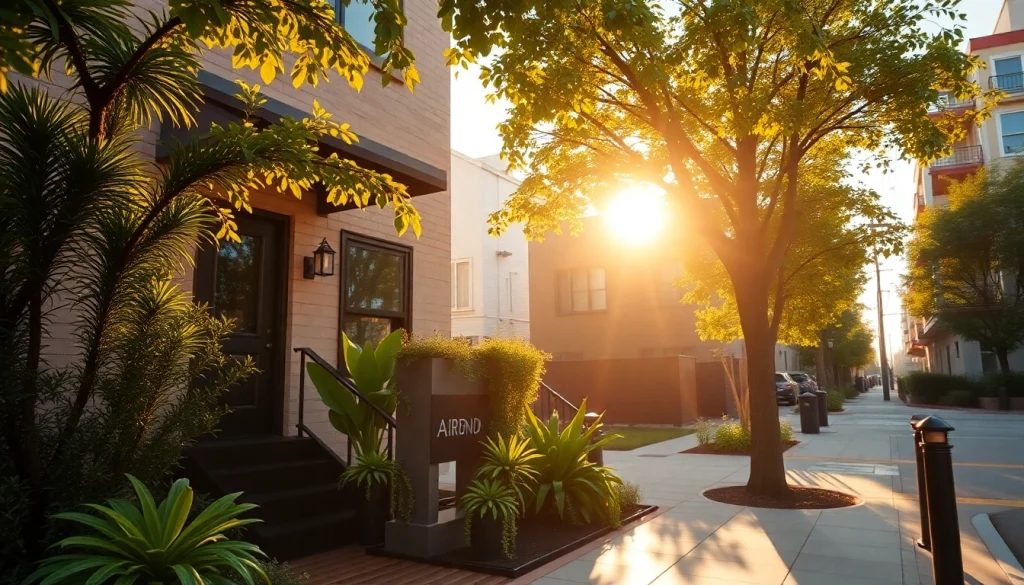
Understanding the Airbnb Property Market
The Airbnb property market has rapidly evolved from its inception, emerging as a viable investment option for savvy real estate investors and entrepreneurs. With the acceleration of short-term rentals due to shifting travel trends and changing consumer behaviors, identifying the right airbnb property for sale is paramount. Dive deeper into the nuances of this marketplace to understand its intricacies and potential returns.
Overview of Airbnb Property for Sale Trends
In recent years, the Airbnb market has seen consistent growth. According to industry reports, more than 7 million properties are now listed on the platform worldwide, with thousands of new properties added every day. This rapid expansion has led investors to capitalize on the opportunity, often resulting in a fierce competition for prime listings.
Several trends have emerged affecting property availability and performance: urban migration post-COVID-19, growing demand for remote working accommodations, and an increase in domestic travel. This has influenced regions differently, where locations previously undervalued have become hotspots due to the influx of investment in short-term rental properties.
Factors Influencing Airbnb Investment Returns
The profitability of an Airbnb property hinges on numerous factors including location, property type, local regulations, and market saturation. Understanding these elements allows investors to predict occupancy rates and revenue potential more accurately.
1. Location: Properties in urban centers or tourist attractions typically yield higher returns due to consistent demand.
2. Seasonality: Seasonal destinations can greatly affect occupancy rates, thereby impacting annual revenue.
3. Property Type: Features such as the number of bedrooms, amenities, and unique characteristics (like historical buildings) can influence guest interest and pricing.
4. Local Laws: Stricter regulations can limit short-term rentals, affecting availability and potential income.
By analyzing these factors, investors can make informed decisions and project more reliable returns.
Regional Variations in Airbnb Property Demand
Understanding the regional dynamics of the Airbnb market is crucial. For instance, markets like New York, Los Angeles, and Miami offer high occupancy rates but are often accompanied by stringent regulations that can complicate investment. Conversely, emerging markets like parts of Texas and Florida provide lucrative opportunities with less competition and regulatory constraints.
Investors should regularly monitor market changes and local economic developments to assess where opportunities may arise. Platforms like AirDNA provide valuable data analytics on market trends, occupancy rates, and revenue potential across various locations.
How to Evaluate Airbnb Properties for Sale
When considering an investment in an Airbnb property, thorough evaluation is essential. This section will outline the steps involved in assessing potential properties to ensure sound investment decisions.
Key Metrics to Consider When Buying
Identifying key performance indicators (KPIs) will help gauge the potential success of an Airbnb investment. Here are some crucial metrics:
- Cap Rate: The capitalization rate offers insight into the property’s expected return on investment, calculated as net operating income divided by the purchase price.
- Average Daily Rate (ADR): The average rate at which a property is rented out daily. Higher ADRs can lead to improved revenue.
- Occupancy Rate: The percentage of days a property is rented. A higher rate usually correlates with better returns.
- Revenue Per Available Room (RevPAR): This metric combines occupancy rates and ADR, giving a comprehensive view of potential income.
Investors must analyze these metrics together, as financial viability often involves a balance across these KPIs.
Analyzing Property Location and Viability
Location is a primary driver of Airbnb property success. Factors to consider include:
- Proximity to Attractions: Properties close to popular attractions or local experiences consistently receive higher booking rates.
- Transportation Access: Easy access to public transport or major roadways enhances guest convenience, thus raising occupancy rates.
- Neighborhood Safety and Amenities: Properties in safe neighborhoods with access to amenities like restaurants and parks tend to attract more guests.
Extensive research, including visiting potential neighborhoods and evaluating their growth trends, can further hone your investment decision.
Red Flags to Look for in Airbnb Listings
Caution is warranted when looking at Airbnb properties for sale. Here’s what to watch for:
- High Vacancy Rates: This may suggest issues with the property or poor management practices.
- Neglected Maintenance: Signs of wear and tear can indicate potential costly renovations.
- Unfavorable Neighborhood Trends: Areas experiencing declining property values or increased crime may pose a risk to occupancy and rental rates.
- Lack of Documentation: Properties without clear financial records may hide potential liabilities.
Taking the time to investigate these elements can mean the difference between a wise investment and a regrettable decision.
Financing Options for Airbnb Property Purchases
Securing adequate funding is a pivotal step in acquiring an Airbnb property. This section outlines the primary financing options available to aspiring investors.
Types of Loans Available for Investors
Investors have several types of loans suited for purchasing Airbnb properties:
- Conventional Mortgages: Traditional loans suitable for purchasing homes, but they often require a higher down payment for investment properties (typically 15-25%).
- Portfolio Loans: Offered by local banks that keep the loans in-house, these often have less stringent requirements.
- Hard Money Loans: Short-term loans from private lenders that can be secured quickly; however, they often come with higher interest rates.
- Home Equity Loans or Lines of Credit (HELOC): Beneficial for existing homeowners looking to leverage their equity to purchase additional properties.
Choosing the right loan type depends significantly on individual financial situations and investment strategies.
Down Payment Requirements for Short-Term Rentals
Down payment requirements for Airbnb properties can vary considerably based on the property type and lender. Here’s the typical range:
- Investment Properties: Expect to pay between 15% and 25% down, as lenders view short-term rentals as higher-risk compared to traditional homes.
- Owner-occupied Short-Term Rentals: Homebuyers occupying part of their property may access lower down payment options, potentially as low as 3% to 5%.
Understanding these requirements helps investors budget accordingly and secure financing effectively.
Creative Financing Strategies
In addition to traditional loans, there are numerous creative financing strategies investors may explore:
- Partnerships: Pooling resources with other investors can help mitigate financial strain while expanding purchasing power.
- Seller Financing: Involves the seller offering a loan to the buyer, facilitating a smoother purchase process.
- Lease Options: Renting with the option to buy allows investors to secure a property while generating income without immediate commitment.
- FHA Loans: First-time homebuyers may utilize Federal Housing Administration (FHA) loans for residential properties, including those approved for short-term rentals.
By exploring alternative financing options, investors can leverage their capital more effectively while spreading risk.
Maximizing Your Airbnb Investment
Once an investment is secured, the focus shifts to maximizing the property’s income potential. This section discusses strategies for optimizing performance and enhancing guest satisfaction.
Best Practices for Property Management
Effective property management is crucial for a successful Airbnb investment. Here are essential practices:
- Regular Maintenance: A well-maintained property enhances guest experience and reduces repair costs.
- Clear Communication: Prompt responses to guest inquiries can lead to positive reviews and repeat bookings.
- Flexible Check-In/Check-Out Options: Accommodating guest schedules can significantly improve satisfaction rates.
- Professional Cleanliness Standards: Hire reliable cleaning services to ensure properties remain in excellent condition.
By prioritizing guest experiences and maintaining high operational standards, property owners can foster loyalty and positive feedback, both of which drive higher occupancy rates.
Enhancing Guest Experience for Better Returns
Providing an exceptional guest experience is essential not only for securing positive reviews but also for maximizing revenue. Consider these strategies:
- Personal Touches: Welcome baskets or personalized messages can create a memorable experience for guests.
- Local Recommendations: Share helpful tips or curated lists of local attractions and hidden gems to enrich guests’ stays.
- Stylish and Comfortable Accommodations: Invest in quality furnishings and decor that blend comfort with aesthetics.
- Streamlined Check-In Processes: Simplifying guest access, such as keyless entry systems, can enhance convenience.
Diligently crafting guest experiences translates into improved property ratings and increased demand.
Utilizing Data for Pricing and Occupancy Rates
Data analysis plays a pivotal role in setting optimal pricing and occupancy strategies. Here are tools and approaches to consider:
- Market Research Tools: Platforms like AirDNA and Beyond Pricing offer invaluable insights into market dynamics, allowing tailored pricing strategies.
- Dynamic Pricing: Adjusting pricing according to demand fluctuations can significantly increase occupancy rates.
- Comprehensive Performance Reviews: Regular assessments of booking patterns can guide investment decisions and operational adjustments.
By employing analytical tools, investors can create data-driven strategies that optimize pricing and occupancy rates, improving overall revenue.
Future Trends in Airbnb Property Investments
As the landscape of short-term rentals evolves, staying abreast of emerging trends is crucial for making informed investment choices. This section delves into anticipated market shifts and opportunities on the horizon.
Impact of Market Changes on Investment Strategies
Market fluctuations, particularly those influenced by economic factors, technological advancements, and societal preferences, will shape investment strategies in the coming years. Some critical trends include:
- Remote Work Influence: As remote work becomes more normalized, areas previously overlooked may emerge as prime investment targets, driven by demand for “work-cations.”
- Sustainable Practices: Increasing consumer awareness towards eco-friendly options will influence property renovation and management decisions.
- Technological Integration: Smart home features and seamless technology will become standard as guests prefer modern conveniences.
By understanding these trends, investors can recalibrate their approaches and better position themselves for success in the evolving rental landscape.
Emerging Markets for Airbnb Properties
Several regions have started to gain traction as attractive markets for Airbnb investments:
- Suburban Areas: With a shift toward less densely populated locales, suburbs are seeing increased demand.
- International Destinations: Countries with burgeoning tourism sectors can provide high return opportunities.
- College Towns: Properties near universities serve a dual purpose – short-term visitor rentals and student lodging during off-peak months.
Investors looking for novel opportunities should actively monitor these emerging markets and should prepare to pivot their strategies accordingly.
Technology’s Role in the Future of Airbnb Investments
Technology continues to shape the property landscape. Innovations drastically affect how properties are rented and managed:
- Smart Technology: Integration of smart locks, heating, and lighting systems will enhance guest comfort and streamline operations.
- Data Analytics Tools: Continued investment in robust analytic tools will help owners generate and process insights for optimizing their operations.
- Virtual Reality Tours: Properties utilizing VR technology can provide immersive experiences, enhancing marketing efforts and augmenting guest interest.
By embracing technology, investors can automate and optimize their operations, creating a superior guest experience while maximizing returns.






